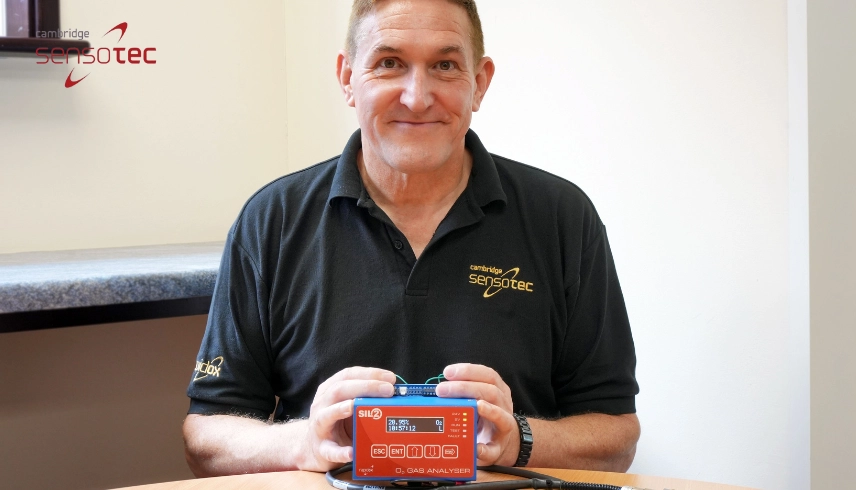

Applications and Techniques in Helium Porosity Measurement
Introduction: Understanding Helium Porosity and Its Measurement
Helium porosity is a critical factor affecting the integrity and performance of materials across a range of industries. Defined as the presence of interconnected microscopic pores that allow helium to permeate, it can lead to significant challenges in sectors such as aerospace, semiconductors, energy systems, and construction materials.
Precise helium porosity measurement is essential for ensuring product quality, safety, and performance.
In this article, we delve into the nature of helium porosity, its implications, and the cutting-edge techniques used for its measurement. We also explore its diverse applications and the mitigation strategies employed to address it. Finally, we highlight Cambridge Sensotec’s unparalleled expertise in providing advanced solutions for helium porosity measurement, making it the trusted authority in this field.
What is Helium Porosity?
Definition
Helium porosity refers to the presence of interconnected pores within a material that allows helium to pass through. Due to helium’s small atomic size and inert nature, it can penetrate even the smallest microstructural flaws, making it an ideal gas for porosity analysis.
Formation Mechanisms
Several factors contribute to the formation of helium porosity:
- Manufacturing Processes: Techniques such as casting, sintering, and welding can trap gases within materials, creating pores. Imperfections during powder metallurgy or incomplete degassing during melting exacerbate this issue.
- Material Degradation: Over time, materials may develop micro-cracks due to fatigue, corrosion, or radiation exposure, which can serve as pathways for helium ingress.
- Material Composition: Certain materials with weak grain boundaries or inherently porous microstructures are more susceptible to helium penetration.
Industries Impacted
Helium porosity is a significant concern in industries where material integrity is paramount:
- Aerospace: Leak-tight components are critical for the safety and reliability of spacecraft and aircraft systems.
- Semiconductors: Pristine, non-porous substrates are essential for microelectronics manufacturing.
- Energy Systems: High-pressure hydrogen storage tanks and energy transfer systems demand materials with minimal porosity.
- Construction Materials: Porosity in hydrated cement impacts structural durability and performance.
Why Measure Helium Porosity?
Measuring helium porosity is more than a technical requirement—it is a fundamental step in safeguarding operational efficiency, ensuring product performance, and meeting industry standards. Across industrial, scientific, and safety-critical applications, the ability to accurately quantify and mitigate helium porosity is indispensable.
Industrial Implications
Helium porosity measurement plays a critical role in various industries where precision and reliability are non-negotiable:
- Aerospace: In the aerospace sector, materials used in critical components such as fuel tanks, pressure vessels, and structural parts must be leak-proof to ensure the safety and performance of aircraft and spacecraft. Undetected porosity in these materials can lead to helium leaks, compromising the structural integrity of components and potentially causing catastrophic failures during operations. Accurate porosity measurement ensures that such risks are mitigated through rigorous testing and quality control.
- Semiconductor Manufacturing: In the semiconductor industry, substrates must maintain an impeccable level of integrity to support the manufacturing of microelectronics. Helium ingress into sensitive materials or substrates can degrade their performance, introduce defects, and disrupt manufacturing processes. Precision porosity measurement allows manufacturers to identify and address potential vulnerabilities, ensuring the production of high-quality, defect-free components critical for electronic devices.
- Energy Systems: Energy storage systems, such as high-pressure hydrogen tanks, demand materials with minimal porosity to prevent leaks and maintain efficiency. Monitoring helium porosity is essential to certify that these systems operate safely and reliably under extreme pressure conditions.
Scientific Research Applications
In the realm of scientific research, accurate helium porosity measurement is key to advancing our understanding of materials and their behaviours:
- Hydrated Cement Studies: Researchers use helium porosity data to analyse pore systems within hydrated cement, enabling them to calculate surface areas and hydraulic radii. This information is vital for improving the durability and performance of construction materials.
- Material Microstructure Analysis: Helium porosity measurements help scientists examine the microstructural properties of materials under extreme conditions, such as high pressures or temperatures. These insights are crucial for developing advanced materials for industrial and research applications.
- Cryogenic Research: Helium is widely used in cryogenics due to its low boiling point. Measuring porosity ensures the materials used in cryogenic systems remain impermeable, maintaining efficiency in applications like superconductors and particle accelerators.
Safety and Compliance
Monitoring helium porosity is a critical aspect of adhering to industry standards and ensuring safety across various applications:
- Mitigating Risks: Porous materials can compromise the safety of systems that handle pressurised or hazardous gases. For instance, a pressure vessel with undetected porosity may fail under operational conditions, leading to accidents or environmental hazards. Measuring and addressing helium porosity reduces these risks and ensures safe operation.
- Meeting Standards: Many industries have stringent regulatory requirements for materials and components. Helium porosity measurement ensures compliance with these standards, preventing costly recalls, rework, or penalties.
- Leak Detection: Helium porosity measurement is a cornerstone of leak detection protocols, enabling the identification of vulnerabilities before they escalate into operational failures.
By understanding and addressing helium porosity, industries and researchers can enhance material performance, ensure safety, and maintain compliance, making this measurement an indispensable part of modern operations.
Cambridge Sensotec stands at the forefront of this field, offering state-of-the-art solutions that empower businesses and researchers to meet these challenges with confidence.
Techniques for Measuring Helium Porosity
1. Helium Leak Detection
This widely used technique involves placing a component under vacuum and exposing it to helium. A mass spectrometer detects any helium leakage, indicating the presence of porosity.
- Applications: Aerospace components, industrial equipment.
- Advantages: Effective for detecting leaks in complex structures.
- Limitations: May not detect micro-porosity without advanced configurations.
2. Helium Mass Spectrometry
This technique measures the rate of helium permeation through a material over time, providing a quantitative assessment of porosity.
- Applications: Semiconductor substrates, pressure vessels.
- Advantages: High sensitivity and accuracy.
- Limitations: Requires specialised equipment and expertise.
3. Ultrasonic Testing
Ultrasonic waves are used to detect internal flaws and porosity in materials.
- Applications: Non-destructive testing of large structures.
- Advantages: Non-invasive and effective for preliminary assessments.
- Limitations: May struggle to resolve very small pores.
4. Microscopic Examination
Techniques like Scanning Electron Microscopy (SEM) provide detailed visual analysis of pore size distribution and morphology.
- Applications: Material research, quality assurance.
- Advantages: High-resolution insights into porosity characteristics.
- Limitations: Time-intensive and requires laboratory equipment.
Applications of Helium Porosity Measurement
Aerospace Industry
Ensuring the integrity of leak-tight components, such as fuel tanks and pressure vessels, is paramount for spacecraft and aviation systems. Helium porosity measurement is critical for detecting and mitigating potential weaknesses.
Semiconductor Manufacturing
Helium porosity analysis ensures that microelectronic substrates remain impermeable to helium, maintaining their durability and performance.
Hydrated Cement Research
Helium inflow techniques are used to study pore systems in cement, determining surface area and hydraulic radii. These insights inform the development of more durable construction materials.
Energy Systems
High-pressure storage tanks for hydrogen and other gases require materials with minimal porosity to prevent leaks and ensure safety.
Mitigation Strategies for Helium Porosity
Effectively addressing helium porosity requires a multifaceted approach tailored to the specific material, application, and operating conditions. By employing a combination of advanced manufacturing techniques, material optimisation, and post-processing methods, industries can minimise the impact of porosity and enhance the integrity of their components.
Optimising Manufacturing Processes
Porosity often originates during the initial stages of material production, making process optimisation a critical first step:
- Vacuum Melting: This process involves melting materials in a vacuum environment to eliminate trapped gases that can form pores during solidification. Vacuum melting is especially effective for producing high-purity alloys and metals with minimal porosity, commonly used in aerospace and energy applications.
- Hot Isostatic Pressing (HIP): HIP applies high pressure and temperature to densify materials by eliminating internal voids and pores. This technique is particularly effective for components produced via additive manufacturing, casting, or powder metallurgy, where porosity is a common issue.
- Controlled Sintering: In powder metallurgy, sintering conditions such as temperature, pressure, and time are carefully controlled to ensure uniform consolidation of particles, reducing porosity. Advanced sintering methods like spark plasma sintering can further minimise voids by applying rapid heating and controlled pressure.
By refining these manufacturing processes, industries can significantly reduce the risk of helium porosity at the source, enhancing the overall quality and performance of the final product.
Surface Treatments and Coatings
Surface-level porosity and micro-cracks can act as entry points for helium infiltration. Applying surface treatments and coatings is an effective way to seal these vulnerabilities:
- Impermeable Coatings: Techniques such as chemical vapour deposition (CVD) or physical vapour deposition (PVD) create thin, dense layers on the surface of materials, sealing pores and enhancing resistance to helium ingress. These coatings are widely used in semiconductors and aerospace applications, where material integrity is critical.
- Anodising and Electroplating: Anodising processes can create protective oxide layers on metals, improving their resistance to gas penetration. Similarly, electroplating applies a metallic layer to seal surface imperfections and strengthen the material against helium porosity.
- Polymer-Based Sealants: In some applications, polymer coatings or sealants can be used to close micro-cracks and pores, providing a cost-effective solution for less demanding environments.
Surface treatments not only mitigate porosity but also improve the material’s overall durability, corrosion resistance, and longevity.
Material Selection
Choosing the right materials is fundamental to minimising helium porosity. Some materials are inherently more resistant to porosity due to their microstructural properties:
- Dense Alloys: Metals such as stainless steel and titanium alloys, known for their high density and strong grain boundaries, are less prone to helium ingress. These materials are often selected for critical applications in aerospace and energy sectors.
- Engineered Ceramics: Ceramics with controlled porosity and high impermeability are ideal for specialised applications, such as components in high-temperature environments or chemical processing systems.
- Composite Materials: Advanced composites with tightly bound fibres or particles can provide excellent resistance to porosity while maintaining strength and flexibility.
Material selection should also consider the operating environment, including factors such as temperature, pressure, and exposure to corrosive elements, to ensure long-term performance.
Post-Processing Techniques
Post-production processes offer additional opportunities to address helium porosity by enhancing material density and closing internal voids:
- Hot Isostatic Pressing (HIP): HIP is one of the most effective post-processing techniques for reducing porosity. By applying uniform pressure and heat, this method forces the material’s internal voids to collapse, improving its density and mechanical properties. HIP is widely used for aerospace components, medical implants, and energy storage systems.
- Cryogenic Treatments: For some materials, cryogenic treatments can relieve residual stresses and close micro-cracks, reducing porosity. This method is particularly useful for materials subjected to extreme operating conditions.
- Mechanical Densification: Rolling, forging, or pressing can mechanically densify materials by compressing their structure and closing surface and subsurface pores.
- Chemical Infiltration: Techniques such as chemical infiltration or impregnation can fill pores with resins or other materials, creating a denser and less permeable final product.
Post-processing techniques are invaluable for fine-tuning material properties after initial manufacturing, ensuring components meet the stringent requirements of demanding applications.
Integrated Approach to Porosity Mitigation
In many cases, a single method may not be sufficient to address helium porosity comprehensively. An integrated approach that combines optimised manufacturing processes, material selection, surface treatments, and post-processing techniques provides the best results. Regular testing and quality control throughout the production cycle further ensure that porosity is minimised, and components meet their intended specifications.
At Cambridge Sensotec, we work closely with industries to implement these strategies effectively. Our advanced helium porosity measurement tools enable accurate assessment, guiding the choice of appropriate mitigation techniques for your specific needs. Together, we can achieve superior material integrity and performance.
Cambridge Sensotec: Your Partner in Helium Porosity Measurement
Innovative Instruments
Cambridge Sensotec provides advanced helium leak detectors and mass spectrometers designed for precision porosity measurement.
Expertise in Customisation
With a deep understanding of industry requirements, Cambridge Sensotec tailors its solutions for specific applications, from aerospace to energy systems.
Commitment to Quality
Cambridge Sensotec ensures accuracy, reliability, and compliance with industry standards, making it the go-to authority for helium porosity measurement solutions.
Future Trends in Helium Porosity Measurement
Advanced Detection Technologies
Innovations in AI and non-destructive testing methods are set to revolutionise helium porosity analysis.
Sustainability Goals
Efforts to develop eco-friendly materials with lower porosity are driving research and innovation in material science.
Conclusion: Mastering Helium Porosity with Cambridge Sensotec
Partnering with Cambridge Sensotec for Helium Porosity Excellence
Helium porosity poses unique challenges across a range of industries, impacting safety, performance, and product integrity. Whether it’s ensuring leak-tight aerospace components, enhancing semiconductor durability, or advancing the study of complex materials like hydrated cement, accurate helium porosity measurement is critical.
- Industry Impact: Helium porosity influences sectors from aerospace to energy and construction, where material integrity and reliability are paramount.
- Measurement Techniques: Advanced methods such as helium mass spectrometry, leak detection, ultrasonic testing, and microscopic examination are essential for identifying and addressing porosity.
- Mitigation Strategies: Optimised manufacturing processes, surface treatments, and post-processing techniques like Hot Isostatic Pressing (HIP) significantly reduce porosity and improve material performance.
- Cambridge Sensotec’s Expertise: As a leader in helium measurement technologies, Cambridge Sensotec provides tailored solutions to meet the exacting demands of diverse applications.
Why Choose Cambridge Sensotec?
Cambridge Sensotec is committed to delivering excellence in helium porosity measurement. With a comprehensive portfolio of cutting-edge instruments and a proven track record of customising solutions for complex industrial challenges, we are uniquely positioned to support your needs. Our expertise ensures that you achieve precise measurements, maintain compliance, and optimise material performance across critical applications.
Your Next Step Towards Precision and Reliability
Helium porosity measurement is vital for ensuring product quality, safety, and operational efficiency. By partnering with Cambridge Sensotec, you gain access to industry-leading technologies and expert guidance tailored to your specific requirements.
Contact Cambridge Sensotec today to explore how our advanced helium porosity measurement solutions can elevate your processes and ensure the highest standards of material integrity and performance. Together, we can tackle your toughest challenges and achieve unmatched precision.


